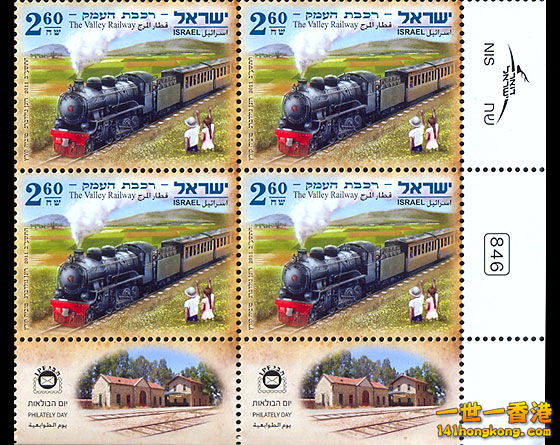|
|
 發表於 2013-11-24 21:48:10
|
顯示全部樓層
發表於 2013-11-24 21:48:10
|
顯示全部樓層
回帖獎勵 +30000 元錢
The Valley Railway Tab Block of 4

“The Valley Railway” (Rakevet HaEmek) is the Hebrew nickname for the Haifa branch line of the famed Hijaz Railway, which was built in the latter days of the Ottoman Empire to connect Damascus to Medina and Mecca in the Hijaz region of the Arabian Peninsula. This railway served both religious and military purposes.
The branch line to Haifa was built from 1903-1906, to transport materials imported by sea and required for the construction of the Hijaz Railway's main line. The branch line relieved the Turkish government of the need to rely on the private railway that already ran from Damascus to Beirut.
The Haifa branch line was largely based on a failed project from the late 19th century, led by a British company that tried to establish a rail line from Haifa to Damascus, and some of the infrastructure and buildings that remain preserved today date back to that project. The line began at the Haifa Station (later Haifa East), continuing southeast along the foot of Mount Carmel to the Jezreel Valley and the city of Afula. From there, the track descended toward Beit She'an, where it turned north and continued through the Jordan Valley to Samakh, where a second main station was established, also serving the city of Tiberias.
From Samakh the rail line continued eastward, ascending toward the Hauran Plateau through the Yarmouk Valley to Daraa in Southern Syria, where it connected to the main line of the Hijaz Railway. This last section of the line posed complex challenges for the railway engineers, eventually leading to the construction of some 15 bridges and 7 tunnels along the Yarmouk alone.
Once the Haifa branch line was completed, additional short branch lines were built from Afula toward Nablus and from Haifa to Acre and a longer branch line was constructed from the Samaria area to the Sinai Peninsula and toward the Gaza Strip in order to serve the Turkish army during World War I. Despite the fact that the section of the line running through the Jezreel and Jordan valleys was short relative to the overall Hijaz Railway network, this became the most prosperous section of the entire railway, partially thanks to the flourishing Jewish settlement throughout those valleys, which gave the Haifa-Samakh line its Hebrew nickname.
At a time when paved roads were scarce and in poor condition, the locations of some of those valley settlements were selected specifically because of their proximity to the rail line. The residents' reliance upon the railway increased its influence over their daily lives and produced many varied memories and stories, from jokes about the train's slowness to a claim that the birth rate in the valley increased due to early morning train whistles.
In the late 1930's the roads in the area improved and the Jewish settlers began to gravitate more toward private vehicles, largely abandoning the railway. Despite a temporary increase in traffic during World War II, the railway's revenue plummeted again immediately afterward and especially after the “Night of the Bridges” in 1946, when the connection to Syria and Jordan was severed. The portion of the line to the east of Afula was damaged during the War of Independence in 1948 and in 1951 Israel Railways shut down the line permanently due to lack of demand.
Work is currently beginning (2011) to re-establish the Haifa-Beit She'an line, this time with a modern railway that will allow travelers to reach Beit She'an from Haifa in 45 minutes, as opposed to the 2-hour trip during the British Mandate. In preparation for the project and during its implementation, efforts are also being made to locate and preserve important built remnants of the original line.
Technical Details
Issue Date: 06.12.2011
Designer: Ronen Goldberg, Tuvia Kurz
Printer: Joh. Enschede, The Netherlands
Process: Offset
Size: 30 mm x 40 mm
Values: USD 2.60 |
|